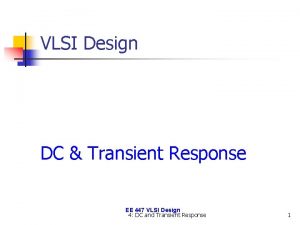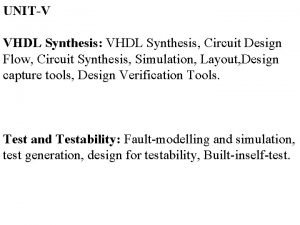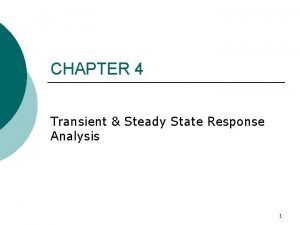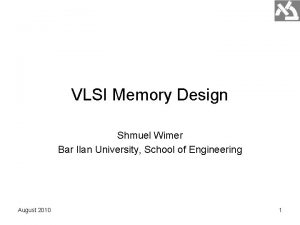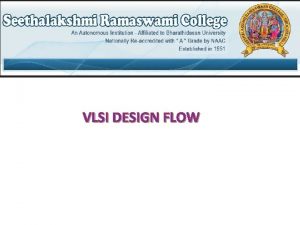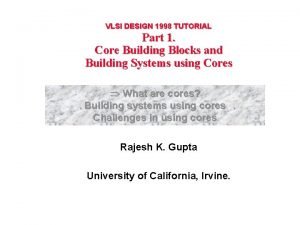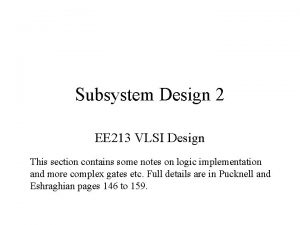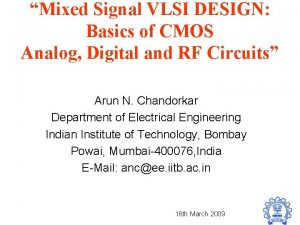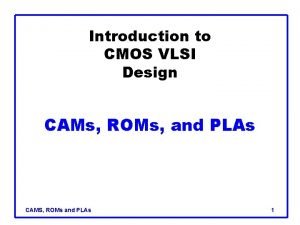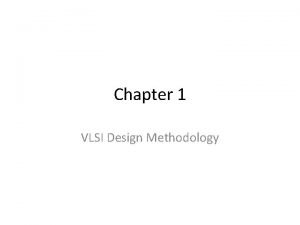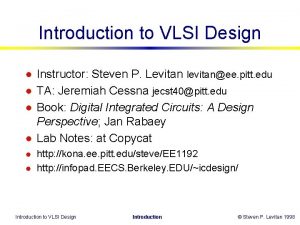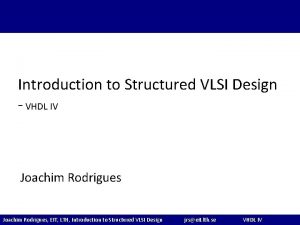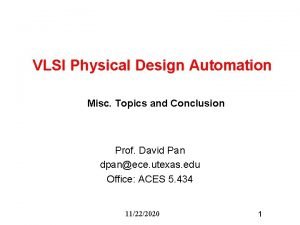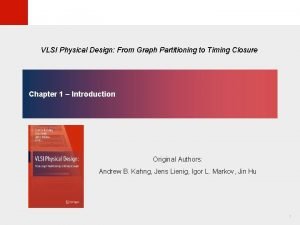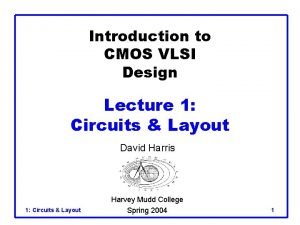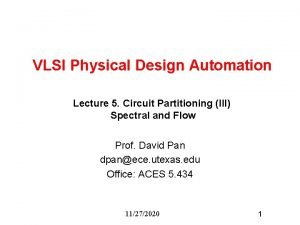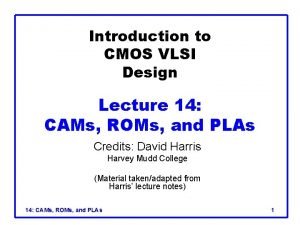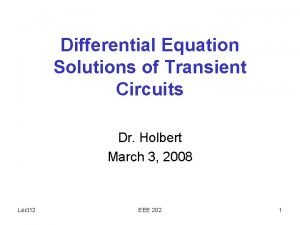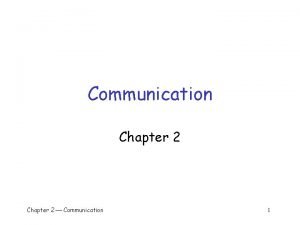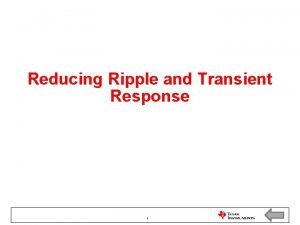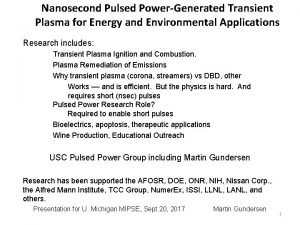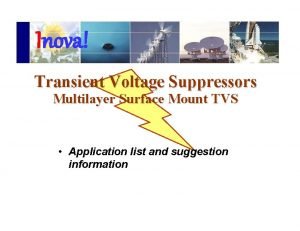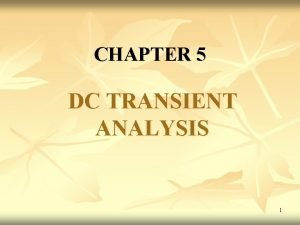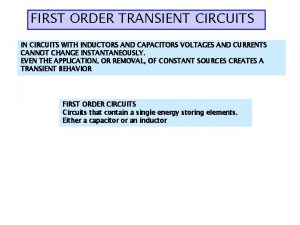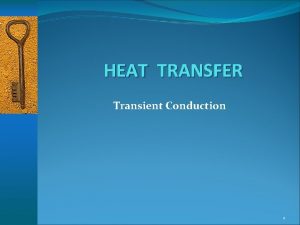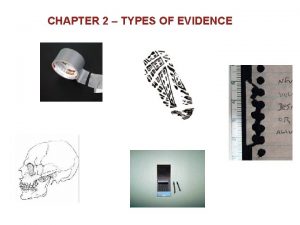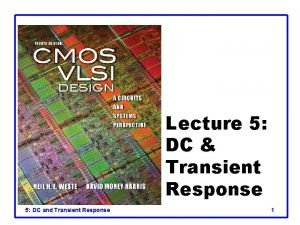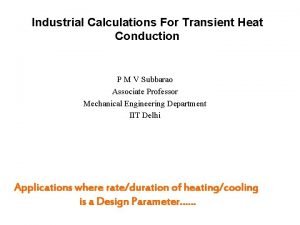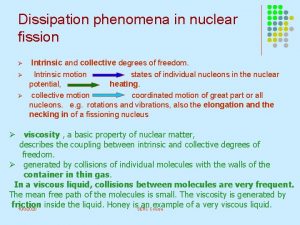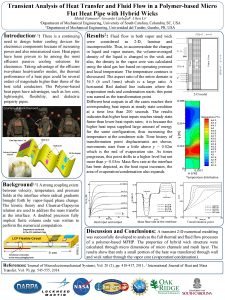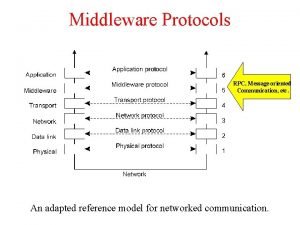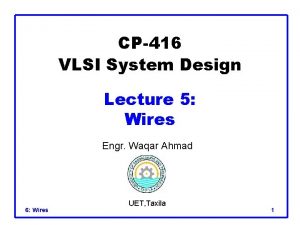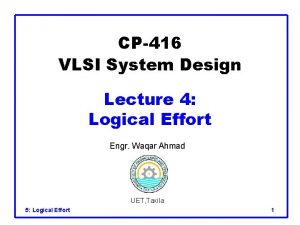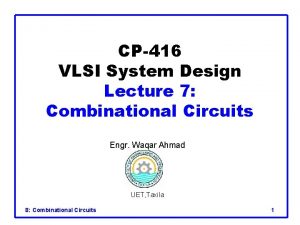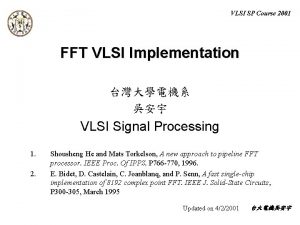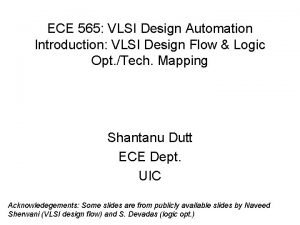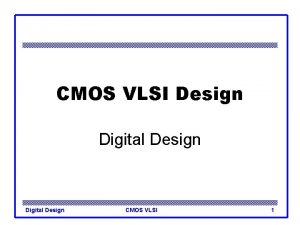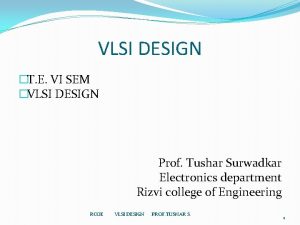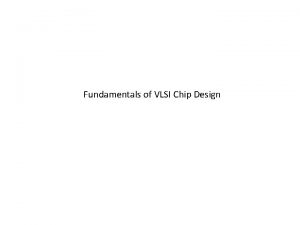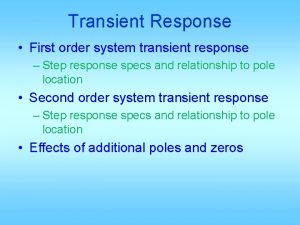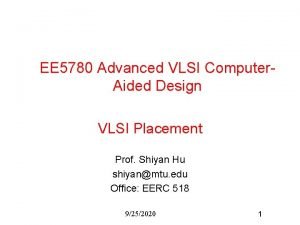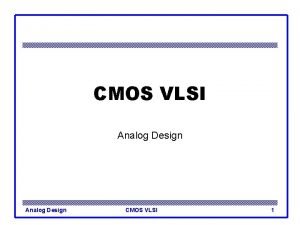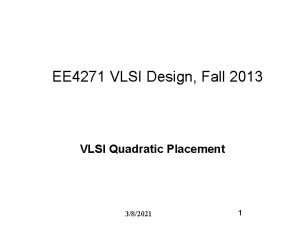CP416 VLSI System Design Lecture 3 DC Transient






























































- Slides: 62

CP-416 VLSI System Design Lecture 3: DC & Transient Response Engr. Waqar Ahmad 4: DC and Transient Response UET, Taxila 1

Outline q q DC Response Logic Levels and Noise Margins Transient Response Delay Estimation 4: DC and Transient Response CMOS VLSI Design 2

Activity 1) 2) 3) 4) 5) 6) If the width of a transistor increases, the current will increase decrease not change If the length of a transistor increases, the current will increase decrease not change If the supply voltage of a chip increases, the maximum transistor current will increase decrease not change If the width of a transistor increases, its gate capacitance will increase decrease not change If the length of a transistor increases, its gate capacitance will increase decrease not change If the supply voltage of a chip increases, the gate capacitance of each transistor will increase decrease not change 4: DC and Transient Response CMOS VLSI Design 3

Activity 1) 2) 3) 4) 5) 6) If the width of a transistor increases, the current will increase decrease not change If the length of a transistor increases, the current will increase decrease not change If the supply voltage of a chip increases, the maximum transistor current will increase decrease not change If the width of a transistor increases, its gate capacitance will increase decrease not change If the length of a transistor increases, its gate capacitance will increase decrease not change If the supply voltage of a chip increases, the gate capacitance of each transistor will increase decrease not change 4: DC and Transient Response CMOS VLSI Design 4

DC Response q DC Response: Vout vs. Vin for a gate q Ex: Inverter – When Vin = 0 -> Vout = VDD – When Vin = VDD -> Vout = 0 – In between, Vout depends on transistor size and current – By KCL, must settle such that Idsn = |Idsp| – We could solve equations – But graphical solution gives more insight 4: DC and Transient Response CMOS VLSI Design 5

Transistor Operation q Current depends on region of transistor behavior q For what Vin and Vout are n. MOS and p. MOS in – Cutoff? – Linear? – Saturation? 4: DC and Transient Response CMOS VLSI Design 6

n. MOS Operation Cutoff Vgsn < 4: DC and Transient Response Linear Vgsn > Saturated Vgsn > Vdsn < Vdsn > CMOS VLSI Design 7

n. MOS Operation Cutoff Vgsn < Vtn 4: DC and Transient Response Linear Vgsn > Vtn Saturated Vgsn > Vtn Vdsn < Vgsn – Vtn Vdsn > Vgsn – Vtn CMOS VLSI Design 8

n. MOS Operation Cutoff Vgsn < Vtn Linear Vgsn > Vtn Saturated Vgsn > Vtn Vdsn < Vgsn – Vtn Vdsn > Vgsn – Vtn Vgsn = Vin Vdsn = Vout 4: DC and Transient Response CMOS VLSI Design 9

n. MOS Operation Cutoff Vgsn < Vtn Vin < Vtn Linear Vgsn > Vtn Vin > Vtn Vdsn < Vgsn – Vtn Vout < Vin - Vtn Saturated Vgsn > Vtn Vin > Vtn Vdsn > Vgsn – Vtn Vout > Vin - Vtn Vgsn = Vin Vdsn = Vout 4: DC and Transient Response CMOS VLSI Design 10

p. MOS Operation Cutoff Vgsp > 4: DC and Transient Response Linear Vgsp < Saturated Vgsp < Vdsp > Vdsp < CMOS VLSI Design 11

p. MOS Operation Cutoff Vgsp > Vtp 4: DC and Transient Response Linear Vgsp < Vtp Saturated Vgsp < Vtp Vdsp > Vgsp – Vtp Vdsp < Vgsp – Vtp CMOS VLSI Design 12

p. MOS Operation Cutoff Vgsp > Vtp Vgsp = Vin - VDD Linear Vgsp < Vtp Saturated Vgsp < Vtp Vdsp > Vgsp – Vtp Vdsp < Vgsp – Vtp < 0 Vdsp = Vout - VDD 4: DC and Transient Response CMOS VLSI Design 13

p. MOS Operation Cutoff Vgsp > Vtp Vin > VDD + Vtp Linear Vgsp < Vtp Vin < VDD + Vtp Vdsp > Vgsp – Vtp Vout > Vin - Vtp Vgsp = Vin - VDD Vtp < 0 Saturated Vgsp < Vtp Vin < VDD + Vtp Vdsp < Vgsp – Vtp Vout < Vin - Vtp Vdsp = Vout - VDD 4: DC and Transient Response CMOS VLSI Design 14

I-V Characteristics q Make p. MOS is wider than n. MOS such that bn = bp 4: DC and Transient Response CMOS VLSI Design 15

Current vs. Vout, Vin 4: DC and Transient Response CMOS VLSI Design 16

Load Line Analysis q For a given Vin: – Plot Idsn, Idsp vs. Vout – Vout must be where |currents| are equal in 4: DC and Transient Response CMOS VLSI Design 17

Load Line Analysis q Vin = 0 4: DC and Transient Response CMOS VLSI Design 18

Load Line Analysis q Vin = 0. 2 VDD 4: DC and Transient Response CMOS VLSI Design 19

Load Line Analysis q Vin = 0. 4 VDD 4: DC and Transient Response CMOS VLSI Design 20

Load Line Analysis q Vin = 0. 6 VDD 4: DC and Transient Response CMOS VLSI Design 21

Load Line Analysis q Vin = 0. 8 VDD 4: DC and Transient Response CMOS VLSI Design 22

Load Line Analysis q Vin = VDD 4: DC and Transient Response CMOS VLSI Design 23

Load Line Summary 4: DC and Transient Response CMOS VLSI Design 24

DC Transfer Curve q Transcribe points onto Vin vs. Vout plot 4: DC and Transient Response CMOS VLSI Design 25

Operating Regions q Revisit transistor operating regions Region n. MOS p. MOS A B C D E 4: DC and Transient Response CMOS VLSI Design 26

Operating Regions q Revisit transistor operating regions Region n. MOS p. MOS A Cutoff Linear B Saturation Linear C Saturation D Linear Saturation E Linear Cutoff 4: DC and Transient Response CMOS VLSI Design 27

Beta Ratio q If bp / bn 1, switching point will move from VDD/2 q Called skewed gate q Other gates: collapse into equivalent inverter 4: DC and Transient Response CMOS VLSI Design 28

Noise Margins q How much noise can a gate input see before it does not recognize the input? 4: DC and Transient Response CMOS VLSI Design 29

Logic Levels q To maximize noise margins, select logic levels at 4: DC and Transient Response CMOS VLSI Design 30

Logic Levels q To maximize noise margins, select logic levels at – unity gain point of DC transfer characteristic 4: DC and Transient Response CMOS VLSI Design 31

Transient Response q DC analysis tells us Vout if Vin is constant q Transient analysis tells us Vout(t) if Vin(t) changes – Requires solving differential equations q Input is usually considered to be a step or ramp – From 0 to VDD or vice versa 4: DC and Transient Response CMOS VLSI Design 32

Inverter Step Response q Ex: find step response of inverter driving load cap 4: DC and Transient Response CMOS VLSI Design 33

Inverter Step Response q Ex: find step response of inverter driving load cap 4: DC and Transient Response CMOS VLSI Design 34

Inverter Step Response q Ex: find step response of inverter driving load cap 4: DC and Transient Response CMOS VLSI Design 35

Inverter Step Response q Ex: find step response of inverter driving load cap 4: DC and Transient Response CMOS VLSI Design 36

Inverter Step Response q Ex: find step response of inverter driving load cap 4: DC and Transient Response CMOS VLSI Design 37

Inverter Step Response q Ex: find step response of inverter driving load cap 4: DC and Transient Response CMOS VLSI Design 38

Delay Definitions q tpdr: q tpdf: q tpd: q tr : q tf: fall time 4: DC and Transient Response CMOS VLSI Design 39

Delay Definitions q tpdr: rising propagation delay – From input to rising output crossing VDD/2 q tpdf: falling propagation delay – From input to falling output crossing VDD/2 q tpd: average propagation delay – tpd = (tpdr + tpdf)/2 q tr: rise time – From output crossing 0. 2 VDD to 0. 8 VDD q tf: fall time – From output crossing 0. 8 VDD to 0. 2 VDD 4: DC and Transient Response CMOS VLSI Design 40

Delay Definitions q tcdr: rising contamination delay – From input to rising output crossing VDD/2 q tcdf: falling contamination delay – From input to falling output crossing VDD/2 q tcd: average contamination delay – tpd = (tcdr + tcdf)/2 4: DC and Transient Response CMOS VLSI Design 41

Simulated Inverter Delay q Solving differential equations by hand is too hard q SPICE simulator solves the equations numerically – Uses more accurate I-V models too! q But simulations take time to write 4: DC and Transient Response CMOS VLSI Design 42

Delay Estimation q We would like to be able to easily estimate delay – Not as accurate as simulation – But easier to ask “What if? ” q The step response usually looks like a 1 st order RC response with a decaying exponential. q Use RC delay models to estimate delay – C = total capacitance on output node – Use effective resistance R – So that tpd = RC q Characterize transistors by finding their effective R – Depends on average current as gate switches 4: DC and Transient Response CMOS VLSI Design 43

RC Delay Models q Use equivalent circuits for MOS transistors – Ideal switch + capacitance and ON resistance – Unit n. MOS has resistance R, capacitance C – Unit p. MOS has resistance 2 R, capacitance C q Capacitance proportional to width q Resistance inversely proportional to width 4: DC and Transient Response CMOS VLSI Design 44

Example: 3 -input NAND q Sketch a 3 -input NAND with transistor widths chosen to achieve effective rise and fall resistances equal to a unit inverter (R). 4: DC and Transient Response CMOS VLSI Design 45

Example: 3 -input NAND q Sketch a 3 -input NAND with transistor widths chosen to achieve effective rise and fall resistances equal to a unit inverter (R). 4: DC and Transient Response CMOS VLSI Design 46

Example: 3 -input NAND q Sketch a 3 -input NAND with transistor widths chosen to achieve effective rise and fall resistances equal to a unit inverter (R). 4: DC and Transient Response CMOS VLSI Design 47

3 -input NAND Caps q Annotate the 3 -input NAND gate with gate and diffusion capacitance. 4: DC and Transient Response CMOS VLSI Design 48

3 -input NAND Caps q Annotate the 3 -input NAND gate with gate and diffusion capacitance. 4: DC and Transient Response CMOS VLSI Design 49

3 -input NAND Caps q Annotate the 3 -input NAND gate with gate and diffusion capacitance. 4: DC and Transient Response CMOS VLSI Design 50

Elmore Delay q ON transistors look like resistors q Pullup or pulldown network modeled as RC ladder q Elmore delay of RC ladder 4: DC and Transient Response CMOS VLSI Design 51

Example: 2 -input NAND q Estimate worst-case rising and falling delay of 2 input NAND driving h identical gates. 4: DC and Transient Response CMOS VLSI Design 52

Example: 2 -input NAND q Estimate rising and falling propagation delays of a 2 input NAND driving h identical gates. 4: DC and Transient Response CMOS VLSI Design 53

Example: 2 -input NAND q Estimate rising and falling propagation delays of a 2 input NAND driving h identical gates. 4: DC and Transient Response CMOS VLSI Design 54

Example: 2 -input NAND q Estimate rising and falling propagation delays of a 2 input NAND driving h identical gates. 4: DC and Transient Response CMOS VLSI Design 55

Example: 2 -input NAND q Estimate rising and falling propagation delays of a 2 input NAND driving h identical gates. 4: DC and Transient Response CMOS VLSI Design 56

Example: 2 -input NAND q Estimate rising and falling propagation delays of a 2 input NAND driving h identical gates. 4: DC and Transient Response CMOS VLSI Design 57

Example: 2 -input NAND q Estimate rising and falling propagation delays of a 2 input NAND driving h identical gates. 4: DC and Transient Response CMOS VLSI Design 58

Delay Components q Delay has two parts – Parasitic delay • 6 or 7 RC • Independent of load – Effort delay • 4 h RC • Proportional to load capacitance 4: DC and Transient Response CMOS VLSI Design 59

Contamination Delay q Best-case (contamination) delay can be substantially less than propagation delay. q Ex: If both inputs fall simultaneously 4: DC and Transient Response CMOS VLSI Design 60

Diffusion Capacitance q we assumed contacted diffusion on every s / d. q Good layout minimizes diffusion area q Ex: NAND 3 layout shares one diffusion contact – Reduces output capacitance by 2 C – Merged uncontacted diffusion might help too 4: DC and Transient Response CMOS VLSI Design 61

Layout Comparison q Which layout is better? 4: DC and Transient Response CMOS VLSI Design 62
 Transient response in vlsi
Transient response in vlsi Cmos vlsi design lecture notes
Cmos vlsi design lecture notes Design flow of vlsi system
Design flow of vlsi system 01:640:244 lecture notes - lecture 15: plat, idah, farad
01:640:244 lecture notes - lecture 15: plat, idah, farad Transient response of first order system
Transient response of first order system Transient line source technique
Transient line source technique Dynamic response
Dynamic response Memory design in vlsi
Memory design in vlsi Vlsi design flow y chart
Vlsi design flow y chart Biucache
Biucache Subsystem design in vlsi
Subsystem design in vlsi Mixed signal vlsi design
Mixed signal vlsi design Rom design in vlsi
Rom design in vlsi Intro to vlsi
Intro to vlsi Y chart in vlsi
Y chart in vlsi Cmos design rules
Cmos design rules Look up table in fpga
Look up table in fpga Ad hoc testable design techniques in vlsi
Ad hoc testable design techniques in vlsi Introduction to vlsi
Introduction to vlsi Structured vlsi design
Structured vlsi design Physical design
Physical design Vlsi design styles
Vlsi design styles Vlsi design flow
Vlsi design flow O3ai gate
O3ai gate Design partitioning in vlsi
Design partitioning in vlsi Rom design in vlsi
Rom design in vlsi Stereotypic movement disorder
Stereotypic movement disorder Secular equilibrium
Secular equilibrium Adam moulton method
Adam moulton method Transient communication examples
Transient communication examples @transient in jpa
@transient in jpa Natural solution
Natural solution Transient synchronous communication
Transient synchronous communication Conditional evidence example
Conditional evidence example Examples of transient evidence
Examples of transient evidence Transient markov chain
Transient markov chain Transient hypofrontality
Transient hypofrontality Ripple transient
Ripple transient Transient plasma systems
Transient plasma systems Surface mount transient voltage suppressor
Surface mount transient voltage suppressor Transient threat definition
Transient threat definition Who
Who Dc transient analysis
Dc transient analysis Examples of transient evidence
Examples of transient evidence Transitional signals
Transitional signals First order transient circuit
First order transient circuit Transient contact
Transient contact Ronald cotton bobby poole
Ronald cotton bobby poole Lumped system analysis
Lumped system analysis Classification of physical evidence
Classification of physical evidence Conditional evidence example
Conditional evidence example Transient market segment
Transient market segment Rw + vo c inverter transient response vod inverte...
Rw + vo c inverter transient response vod inverte... Transient heat transfer in industry
Transient heat transfer in industry Transient time
Transient time Transient analysis thermodynamics
Transient analysis thermodynamics Developing person through childhood
Developing person through childhood Message oriented communication
Message oriented communication Practical design to eurocode 2 lecture 3
Practical design to eurocode 2 lecture 3 Urban design lecture
Urban design lecture Elements and principles of design ppt
Elements and principles of design ppt Lecture hall acoustics
Lecture hall acoustics Game design lecture
Game design lecture
